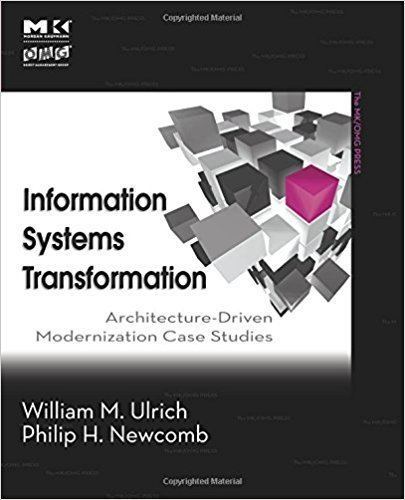Name William Ulrich | ||
 | ||
Books Information Systems Transformation: Architecture-Driven Modernization Case Studies | ||
William M. Ulrich (born c. 1956) is an American business architecture consultant, consultant at Cutter Consortium, director and lecturer, known for development of 'The Systems Redevelopment Methodology' (TSRM) in the 1990s, on legacy systems in the 2000s and more recently on his work on business architecture.
Contents
- Biography
- The Systems Redevelopment Methodology
- Legacy systems transformation strategies 2002
- Business Architecture Guild
- Business Architecture The Art and Practice of Business Transformation 2010
- Selected publications
- References
Biography
Ulrich started to study at the Western Illinois University in 1974, and obtained his Bachelor of Business, Management Information Sciences in 1978.
After graduation Ulrich started his working in industry. In 1980 he was working for Automated Concepts Inc. on reengineering and reverse engineering. He joined KPMG Peat Marwick in 1983 as Director of Reengineering Strategies, and was promoted into senior management in 1986. In 1990 he founded his own management consultancy firm TSG, INC. Since 2003 he is also became Senior Consultant at Cutter Consortium (now Fellow), and since 2010 president of the Business Architecture Guild. Ulrich lectured at the Northeastern Illinois University, and at the Software Engineering Institute. In the Object Management Group (OMG) he co-chairs the Architecture-Driven Modernization Task Force. In 2016, along with Whynde Kuehn, Ulrich co-founded Business Architecture Associates, Inc., an international training and mentoring company. Ulrich holds Certified Business Architect® certification from the Business Architecture Guild.
The Systems Redevelopment Methodology
The Systems Redevelopment Methodology is developed by Ulrich in the early 1990s. It contained a "set of project management templates and guidelines for transition projects" and it was marketed by James Martin and Company in Reston, Virginia.
The methodology was especially designed to assist organizations "migrate large, aging systems into strategic architectures that support tomorrow's business needs."
Legacy systems: transformation strategies, 2002
In his 2002 "In Legacy Systems: Transformation Strategies" Ulrich presents "a step-by-step, phased roadmap to legacy transformation that maximizes business value, while minimizing cost, disruption, and risk. Transformation strategies, organizing disciplines, techniques, and tools reduce the risks of deploying the component-based architectures you need to stay competitive while maximizing the business value of core systems that work."
Business Architecture Guild
In 2010 Ulrich cofounded the Business Architecture Guild with Michael Rosen and others. Its primary purpose is "to promote best practices and expand the knowledge-base of the business architecture discipline." The Guild is a not for profit, international membership organization for practitioners and others interested in the developing the field of business architecture.
Founded in late 2010, the Guild opened up membership in the fall of 2011 based on the initial release of the A Guide to the Business Architecture Body of Knowledge (BIZBOK® Guide). BIZBOK® Guide, currently at version 5.0 is a "practical guide for business architecture practitioners and individuals who wish to use business architecture to address business challenges. This practical guide comes in the form of best practices, gleaned from numerous companies and business architecture leaders."
Business Architecture: The Art and Practice of Business Transformation, 2010
In the Business Architecture: The Art and Practice of Business Transformation, Ulrich and McWhorter summarized the essence of business architecture:
The most important aspect of business architecture is enabling business executives, managers and professionals to take ownership and drive enterprise transformation, a role that has oftentimes been delegated by default to IT. Historically, the term “enterprise architecture” has a tendency to turn off business professionals because they immediately assume that the concept is an IT focused creation. This is not an indictment of IT but rather a call to action for business executives to take ownership of business architecture and related business transformation strategies. The decisions that are made today can make or break organizations going forward into a complex, uncertain future.
Selected publications
Articles, a selection:
